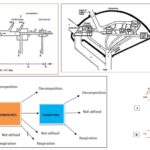O Level Biology 86 Views 1 Answers
Sourav PanLv 9November 2, 2024
Understand that water is absorbed from the lumen of the small intestine and the colon, but that most absorption of water happens in the small intestine
Understand that water is absorbed from the lumen of the small intestine and the colon, but that most absorption of water happens in the small intestine
Please login to save the post
Please login to submit an answer.
Sourav PanLv 9May 15, 2025
Water absorption occurs primarily in the small intestine and to a lesser extent in the colon, playing a vital role in maintaining fluid balance in the body. Here’s a detailed explanation of how water is absorbed in these regions, emphasizing that most absorption happens in the small intestine.
Water Absorption in the Small Intestine
- Volume of Fluid Processed:
- The small intestine receives a significant volume of fluid daily, approximately 9 to 10 liters, which includes about 1 to 2 liters of dietary fluids and an additional 6 to 7 liters from secretions (saliva, gastric juices, pancreatic secretions, and bile).
- By the time the contents reach the large intestine, around 80% of this fluid has already been absorbed .
- Mechanism of Absorption:
- Water absorption in the small intestine primarily occurs through osmosis, a process driven by osmotic gradients created by the absorption of solutes (such as sodium and chloride ions).
- As solutes are actively transported from the intestinal lumen into the epithelial cells lining the small intestine, water follows by osmosis to maintain osmotic balance. This movement can occur through both transcellular (through cells) and paracellular (between cells) pathways.
- Surface Area for Absorption:
- The extensive surface area provided by villi and microvilli in the small intestine enhances water absorption efficiency. The increased surface area allows for greater contact between water and absorbent surfaces, facilitating osmotic movement.
Water Absorption in the Colon
- Role of the Colon:
- While most water absorption occurs in the small intestine, the colon also plays a significant role in reclaiming water from indigestible food matter.
- The colon absorbs about 1 to 2 liters of water daily from the remaining contents that pass into it from the small intestine.
- Mechanism in the Colon:
- Similar to the small intestine, water absorption in the colon is also primarily passive and occurs through osmosis. However, the epithelial cells lining the colon have tight junctions that limit permeability compared to those in the small intestine.
- The colon’s ability to absorb water is crucial for forming solid stools and preventing dehydration.
0
0 likes
- Share on Facebook
- Share on Twitter
- Share on LinkedIn
0 found this helpful out of 0 votes
Helpful: 0%
Helpful: 0%
Was this page helpful?




